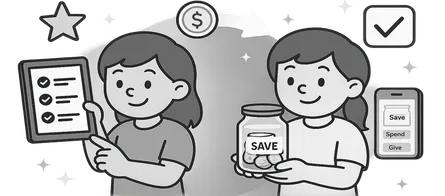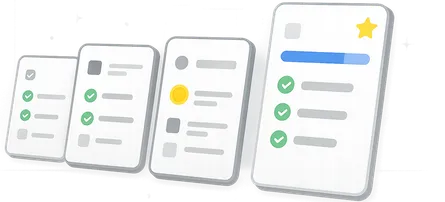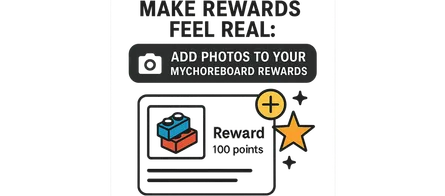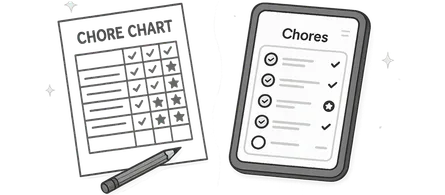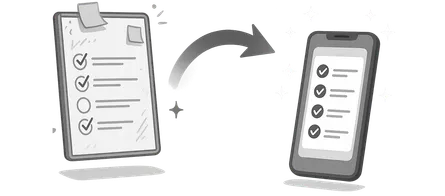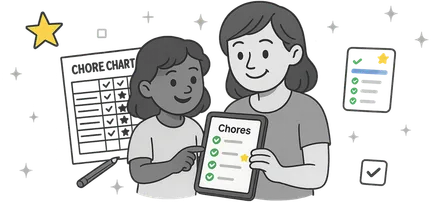
Family Rollout Plan: Getting Kids Onboard with a Chore App
- Jacob Volk
- Parenting , Setup Guide
- 23 Sep, 2025
Getting your kids excited about a new chore app isn’t just about tech — it’s about psychology. Families succeed when they roll it out with clear expectations, fun rewards, and a shared sense of ownership. This guide walks you through a one-week rollout plan that actually works, complete with parent-tested scripts, reward ideas, and small adjustments that turn chores from nagging battles into everyday wins.
App Configuration
This isn’t about cramming in 20 chores — it’s about setting your family up for success. Keep things simple at first so everyone feels confident and consistent.
- Chores: Add all household tasks into the app so you have a complete list to pull from.
- Rewards: Pick 2–3 meaningful rewards that motivate your kids — small treats, experiences, or privileges.
- Scheduling: Assign 3–5 daily chores per child, split between morning and evening.
- Start Using: Do short practice runs — checklists before breakfast and bedtime work best.
- Keep Iterating: Review points and rewards weekly, adjusting difficulty or values as routines settle in.
Need help finding the best chore app for your family? Check this out: Best Free Chore Apps in 2025: Honest Feature Comparison.
Scripts That De-Nagnify Chores
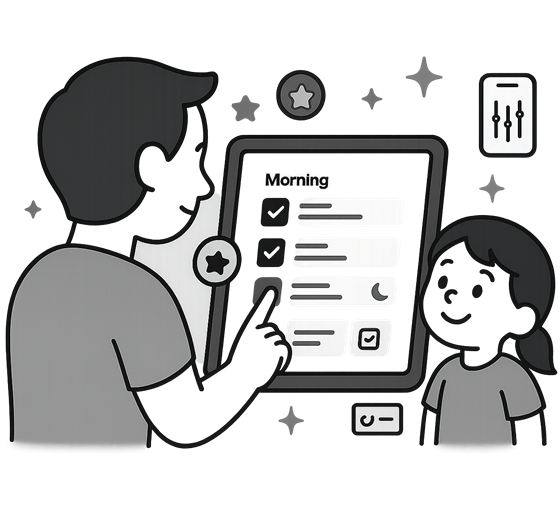
Words matter — and how you introduce a system determines whether it sticks or sparks pushback. These short, parent-tested scripts help shift the dynamic from nagging to ownership. When chores come from the app instead of constant reminders, kids feel more in control, and parents can step back while routines run themselves.
-
“Team talk” (family meeting):
We’re all on the same team here. This list just shows what needs to get done — no reminders, no arguments. You check it off when you finish, and we all win together.” -
“Morning list” (before breakfast):
““Before we eat, take a minute to check your list. Knock out your morning jobs first, then you’re good to go for the day.” -
“Evening closeout” (after dinner):
“Let’s close out the day strong. Check your list one last time — if everything’s green, you’re all set and can relax.”
Rewards That Actually Motivate
Kids don’t work for the joy of vacuuming — they work for connection, pride, and a little bit of payoff. The goal isn’t to “bribe” kids but to help them see the link between effort and reward. When rewards are meaningful and predictable, kids stay motivated without needing constant reminders.
Start small and keep it consistent. Rewards don’t have to cost much — what matters is that they feel earned but exciting, and that you celebrate progress rather than perfection. A quick high-five, a sticker, or the freedom to choose the next family movie can go a long way.
Reward Ideas That Work
- Under-$5 treats: Popsicles, stickers, fidget toys, or a snack of their choice.
- Experience rewards: Pick the movie, choose dinner, plan a family walk, or bonus park time.
- Non-cash perks: Extra screen time, skipping one small chore, staying up 15 minutes late, or a “parent swap” pass (they pick who reads bedtime stories).
💡 Tip: The smaller the reward, the quicker the feedback loop — which keeps motivation high. Save bigger rewards (like allowance payouts or special outings) for weekly or monthly goals.
Keep It Fair and Predictable
Set a weekly cap so rewards stay balanced and kids know what to expect. For example, three small wins can equal one larger prize at week’s end. Consistency builds trust — when kids see that effort equals reward every time, they start internalizing the routine itself as the real payoff.
If your family uses allowance, you can also layer the systems: points and badges for daily chores, then a small allowance payout each week. That balance teaches both responsibility and early financial literacy.

Troubleshooting Common Pushback
Even the best systems hit bumps in the first few weeks. Most “pushback” from kids isn’t defiance — it’s just testing new boundaries. Stay calm, stay consistent, and remember that how you respond matters more than the app itself.
-
“I forgot.”
Totally normal in the first week. Kids are still forming the habit. Keep the tablet in a visible, high-traffic spot — kitchen counter, hallway shelf, or near the breakfast table. Give one neutral reminder (“Check your list before you eat”) and let the app do the rest. -
“This is boring.”
What feels routine to you can feel repetitive to kids. Rotate chores weekly, mix in creative or seasonal tasks (like “pick a dinner side” or “help water the plants”), and use small surprise rewards to re-engage interest. The key is variety without chaos. -
“It’s unfair.”
This usually means a task feels harder than its reward. Show your kids how points work — transparency builds trust. Use clear point values, and for bigger chores, keep parent approvals turned on so kids know extra effort will be noticed. -
Siblings competing.
A little competition can motivate, but it can also create stress. Frame progress as personal: celebrate individual streaks and milestones (“You’ve hit 5 mornings in a row!”) rather than comparing siblings. Shared family goals (“When everyone hits their streak this week, we’ll do a pizza night!”) also help keep teamwork in focus.
💡 Pro tip: Avoid resetting points or charts abruptly. Let kids see their progress grow over time — it reinforces accountability and pride in their work.
Keep Momentum Going
Once your kids are checking their lists daily, the goal shifts from starting habits to keeping them steady. Progress sticks when it feels positive, predictable, and just a little bit fun.
- Add slowly: Introduce only one new chore per week so routines stay achievable. Too many changes at once can overwhelm kids (and parents).
- Celebrate small wins: Recognition matters more than rewards. High-fives, silly dances, or a special sticker on the screen can turn effort into pride.
- Use encouraging language: Say “You earned it” instead of “Finally, you did it.” This subtle shift reinforces autonomy and effort, not compliance.
- Create visual progress: Highlight streaks, badges, or progress bars inside the app — they’re powerful motivators for kids who thrive on seeing results.
- Reset together: At the end of each week, do a 2-minute family “reset.” Review what worked, adjust chores, and celebrate growth. Small check-ins prevent burnout and keep everyone invested.
The magic formula: Short lists + consistent follow-through + positive tone. Keep it simple, keep it visible, and your kids will keep showing up. Ready to implement? Check out our guide here: How to Switch from a Whiteboard to a Free Chore App.
Frequently Asked Questions
- Use the scripts and let the app become the neutral messenger. When your child forgets, simply say, “What does your list say?” instead of giving direct orders. It shifts accountability to the routine instead of the parent.
- Start with the most motivated kid. Visible progress and rewards often inspire siblings to join in naturally. Avoid turning it into a power struggle — consistency and calm modeling win over time.
- Optional. Many families use a hybrid approach: daily chores earn points or privileges, while a weekly allowance connects to overall participation and attitude. The goal is to teach that consistent effort leads to real-world rewards.
- Ages 4–6 do best with picture-based chores and instant rewards. Tweens (8–12) enjoy streaks, badges, and competition. Teens appreciate the autonomy — especially if the app connects effort to allowance or privileges.
- Keep parent approvals turned on for key chores, but focus on coaching rather than criticizing. Use phrases like, “Let’s check together,” or “Next time, try it this way.” Over time, kids learn that thorough work earns faster approvals.
- Very little. Kids typically spend under two minutes checking off tasks each session. MyChoreBoard is designed to be visual and efficient — the screen reinforces accountability, not entertainment.
- Most families see smoother mornings within one week and consistent independence after two to three weeks. The more predictable your cues and praise, the faster the routine sticks.

Ready to try MyChoreBoard with your kids?
Install on any phone, tablet or computer. Free with no sign-in hoops.
Get Started Now




